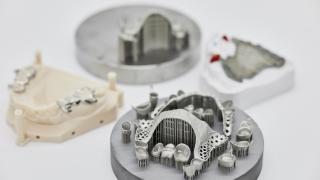
Manufacturing dentures using 3D printing methods makes the process fast, flexible and simple and one company that is benefiting from this technology is CADSPEED, a CAD digital milling centre based in Hanover. It uses a TRUMPF TruPrint 1000 to manufacture dentures for dentists, orthodontists and dental laboratories throughout Europe and confirms significantly higher productivity, improvement in product quality and far less material wastage as a result of this investment.
Using traditional methods, a dental technician would normally produce one tooth in 20 minutes. However, in the space of just two to three hours, the TRUMPF TruPrint 1000 can manufacture up to 70 teeth per cycle which equates to less than three minutes per tooth. The process is significantly quicker thanks to the TruPrint’s twin laser beams that act on the denture geometries at the same time.
The TruPrint 1000 is the only small-format system to work with multiple lasers. Its two laser beams manufacture dental products ten times faster than conventional dental milling machines. It also comes with another innovative feature – digital connectivity. With its wireless link to milling machines the TRUMPF TruPrint 1000 can print teeth, with ultra-precision, for mounting on implants. An implant-supported denture replaces not only the visible tooth but provides the root to anchor it.
The conventional method of producing dentures is complicated and very time consuming. Impressions of the patient’s teeth are taken and sent to a dental laboratory for a plaster cast to be made as a template for the dentures. The basic shape is then created using die casting or milling before secondary finishing; the whole process can take several weeks.
By comparison, and thanks to 3D printing, CADSPEED are even able to manufacture dentures overnight if required. Digitisation makes everything much faster and simpler. For example, instead of relying on impression trays, CADSPEED offers it clients the use of intra-oral dental scanners. These are manual scanners equipped with sensor systems which dentists can use to digitally map the patient’s mouth in 3D.
This data can then be processed further directly, negating the need for a plaster cast. As a result, the whole process is faster, affordable and more precise.
The owner of CADSPEED is Hindrik Dehnbostel, a master dental technician who now employs a 38-strong team to manufacture dentures. He tested the TRUMPF TruPrint 1000 for three months before deciding to buy it. But since its installation, the 3D printer has been running in a three-shift mode, five days a week.
“When you’re running at full capacity and need to produce a lot, 3D printing really comes into its own,” Hindrik Dehnbostel confirms. “The system has proven to be both reliable and robust.”
Another important advantage of 3D printing for CADSPEED is improved quality. Dental technicians almost always struggle with space constraints. It’s exceptionally difficult to profile corners and edges using a milling machine – the tooth is simply too small. In addition, the tools cannot reach all areas and sometimes break.
Such problems are eliminated with 3D printing. Even delicate structures can easily be created as the component is built up layer by layer and the process is software controlled. No tools are involved so breakage is not a problem.
3D printing also uses the material more efficiently. In the conventional method, dental technicians first create the basic shape and then hollow it out. This means that up to 80% of the material is wasted. The TRUMPF TruPrint 1000 only needs the exact amount of powder required to create the component which reduces costs and benefits the environment.
Hindrik Dehnbostel concludes: “There’s no avoiding 3D printing. After all, at some point it will be the patient who decides how their denture is manufactured. Today’s generation is increasingly growing up with digitisation in their lives. They know 3D printing produces better quality than milling.”
The TRUMPF TruPrint 1000 is becoming instrumental in industrialising dental 3D printing.